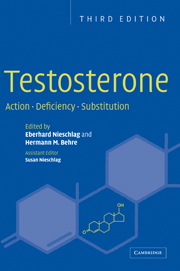Book contents
- Frontmatter
- Contents
- List of contributors
- Preface
- 1 Testosterone: an overview of biosynthesis, transport, metabolism and non-genomic actions
- 2 The androgen receptor: molecular biology
- 3 Androgen receptor: pathophysiology
- 4 Behavioural correlates of testosterone
- 5 The role of testosterone in spermatogenesis
- 6 Androgens and hair: a biological paradox
- 7 Androgens and bone metabolism
- 8 Testosterone effects on the skeletal muscle
- 9 Androgens and erythropoiesis
- 10 Testosterone and cardiovascular diseases
- 11 Testosterone and erection
- 12 Testosterone and the prostate
- 13 Clinical uses of testosterone in hypogonadism and other conditions
- 14 Pharmacology of testosterone preparations
- 15 Androgen therapy in non-gonadal disease
- 16 Androgens in male senescence
- 17 The pathobiology of androgens in women
- 18 Clinical use of 5α-reductase inhibitors
- 19 Dehydroepiandrosterone (DHEA) and androstenedione
- 20 Selective androgen receptor modulators (SARMs)
- 21 Methodology for measuring testosterone, DHT and SHBG in a clinical setting
- 22 Synthesis and pharmacological profiling of new orally active steroidal androgens
- 23 Hormonal male contraception: the essential role of testosterone
- 24 Abuse of androgens and detection of illegal use
- Subject Index
8 - Testosterone effects on the skeletal muscle
Published online by Cambridge University Press: 18 January 2010
- Frontmatter
- Contents
- List of contributors
- Preface
- 1 Testosterone: an overview of biosynthesis, transport, metabolism and non-genomic actions
- 2 The androgen receptor: molecular biology
- 3 Androgen receptor: pathophysiology
- 4 Behavioural correlates of testosterone
- 5 The role of testosterone in spermatogenesis
- 6 Androgens and hair: a biological paradox
- 7 Androgens and bone metabolism
- 8 Testosterone effects on the skeletal muscle
- 9 Androgens and erythropoiesis
- 10 Testosterone and cardiovascular diseases
- 11 Testosterone and erection
- 12 Testosterone and the prostate
- 13 Clinical uses of testosterone in hypogonadism and other conditions
- 14 Pharmacology of testosterone preparations
- 15 Androgen therapy in non-gonadal disease
- 16 Androgens in male senescence
- 17 The pathobiology of androgens in women
- 18 Clinical use of 5α-reductase inhibitors
- 19 Dehydroepiandrosterone (DHEA) and androstenedione
- 20 Selective androgen receptor modulators (SARMs)
- 21 Methodology for measuring testosterone, DHT and SHBG in a clinical setting
- 22 Synthesis and pharmacological profiling of new orally active steroidal androgens
- 23 Hormonal male contraception: the essential role of testosterone
- 24 Abuse of androgens and detection of illegal use
- Subject Index
Summary
Historical aspects of the anabolic steroid controversy
Soon after the biochemical synthesis of testosterone, several groups investigated the anabolic effects of testosterone in animal models. During the 1930s, Kochakian (1935) first described the nitrogen-retaining properties of urinary androgens in the castrate dog. He recorded similar effects of androgens in the castrated male rat and found that the androgen stimulation resulted in dose-related increases in nitrogen retention and body weight (Kochakian 1935; 1937; 1950).
Shortly after the initial animal studies, Kenyon et al. (1940) studied the effects of testosterone propionate in eunuchoidal men, and eugonadal men and women. During androgen treatment, urinary nitrogen excretion diminished, with the greatest magnitude of effects observed in eunuchoidal men. Kenyon concluded presciently that “The … protein estimated as retained by these subjects is not accounted for by increases in the bulk of genital tissues and represents deposit of new material elsewhere in the body” (Kenyon 1940). These observations, combined with the results of the animal studies, allowed the early recognition of the anabolic effects of androgens. It is notable that Kenyon and others were not able to demonstrate sustained increases in nitrogen retention with testosterone supplementation in eugonadal men, an observation that sparked considerable skepticism for the next fifty years about the anabolic effects of supraphysiological doses of androgens in eugonadal men.
Although the use of performance-enhancing products dates back to antiquity, anabolic steroids have emerged as the most prevalent drugs of abuse among athletes in recent decades (Dawson 2001).
- Type
- Chapter
- Information
- TestosteroneAction, Deficiency, Substitution, pp. 255 - 282Publisher: Cambridge University PressPrint publication year: 2004
- 5
- Cited by

